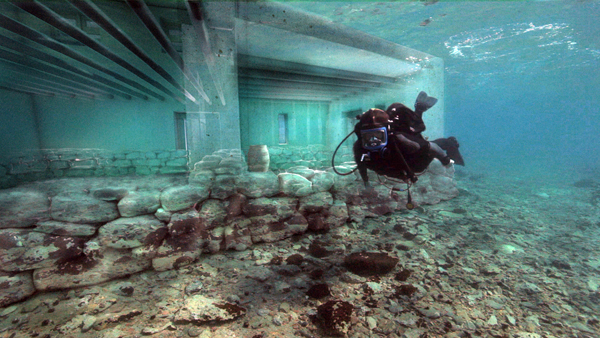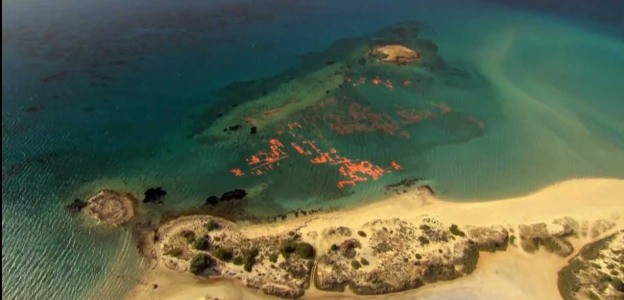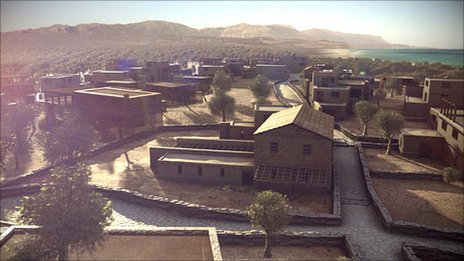The city of Pavlopetri (Greek: Παυλοπέτρι), underwater off the coast of southern Laconia in Peloponnese, Greece, is about 5,000 years old, and is the oldest submerged archeological town site. The name Pavlopetri (“Paul’s and Peter’s”, or “Paul’s stone”) is the modern name for the islet and beach; the ancient name or names are unknown.
Discovered in 1967 by Nicholas Flemming and mapped in 1968 by a team of archaeologists from Cambridge, Pavlopetri is located between the Pavlopetri islet across the Elafonisos village and the Pounta coast. The coast, the archeological site as well as the islet and the surrounding sea area are within the region of the Elafonisos Municipality, the old “Onou Gnathos” peninsula (according to Pausanias). It is unique in having an almost complete town plan, including streets, buildings, and tombs.
Originally, the ruins were dated to the Mycenaean period, 1600–1100 BC but later studies showed an older occupation date starting no later than 2800 BC, so it also includes early Bronze Age middle Minoan and transitional material. It is now believed that the town was submerged around 1000 BC by the first of three earthquakes that the area suffered. The area never re-emerged, so it was neither built-over nor disrupted by agriculture. Although eroded over the centuries, the town layout is as it was thousands of years ago. The site is under threat of damage by boats dragging anchors, as well as by tourists and souvenir hunters.
The submerged architectural remains continue southwards to the islet of Pavlopetri, on top of which the remains of walls and archaeological artefacts are still visible. Also found among the ruins were stone-lined graves, probably from the Meso-Helladic period and in adherence with the practice at the time of burying infants and small children within the settlement. At the edge of the town under two small reefs are two Mycenaean chamber tombs. On the beach at Pouda is an extensive prehistoric cemetery of cist graves dating from the 3rd and 2nd millenia BC. Of particular interest are the ceramic vessels known as pithoi found at the site, in which the prehistoric inhabitants of Pavlopetri stored their wheat, oil and other products such as figs and olives, fish and meat. Other pots found there indicate they had developed close links with Kythera, Crete, the Cyclades and the north-eastern Aegean. Tools made of obsidian from the island of Milos indicate that the prehistoric population of what is now part of Vatika was in contact with the people of the Cyclades since 2,800 BC.
The town reached its peak in the early Mycenaean period (15th century BC). The Mycenaeans would have used the pithoi and other storage vessels found there in order to store the goods they either produced themselves or traded with others. Also found at the site are cups for drinking wine, small vessels decorated with flower patterns for storing aromatic oils, and even sieves, probably used for preparing some kind of beverage. The discovery of a large number of weights used in weaving looms show that the women and children produced textiles and valuable clothing, activities known from Linear B tablets found at Mycenaean palaces at Pylos and Knossos. Garments were dyed with porphyry which was produced in the area as well as on the neighbouring island of Kythera (ancient Porphyroussa).
The people of Pavlopetri were farmers, livestock breeders and fishermen; they produced textiles and processed porphyry for dyes. They traded as early as the Proto-Helladic period (3000 BC).
The settlement appears to have been abandoned in about 1100 BC. The latest archaeological evidence indicates that it was populated once more in the Classical and Hellenistic periods. Roman and Byzantine pottery found there may indicate that the local population was engaged in quarrying and processing porphyry, on which a special tax had been imposed by Emperor Septimus Severus. Under Roman rule, the Strongyli lagoon (now a Natura 2000 wetland) was used by the inhabitants of ancient Vies for producing salt, then a valuable commodity.
Pavlopetri occupied a prominent prehistoric place in the southern part of the Maleas promontory and was one of, if not the most important ports in the southern Peloponnese as it monitored shipping from the ports of southern Laconia to the Aegean and the western Mediterranean. The narrow channel between Elafonisos and Kythera was one of the most important shipping lanes in the Mediterranean, enabling communication between East and West.
The city of Pavlopetri is part of the underwater cultural heritage as defined by the UNESCO in the UNESCO Convention on the Protection of the Underwater Cultural Heritage. All traces of human existence underwater which are one hundred years old or more are protected by the UNESCO Convention on the Protection of the Underwater Cultural Heritage. This convention aims at preventing the destruction or loss of historic and cultural information and looting. It helps states parties to protect their underwater cultural heritage with an international legal framework.
http://en.wikipedia.org/wiki/Pavlopetri
http://blogs.nottingham.ac.uk/pressoffice/2012/06/01/pavlopetri-documentary-on-discovery-channel/



